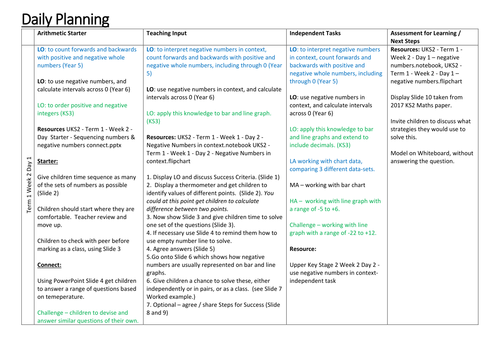





A starter / connect PowerPoint where children sequence and order negative and positive numbers.
An Interactive Whiteboard teaching introduction for both Notebook and ActivInspire, showing how empty number lines to find the difference between negative and positive numbers when applied to temperature. (differentiated 3 ways for ability).
A 4 way differentiated series of independent tasks (including a Mastery Level Challenge Activity) where children to interpret a range of charts, bar and line graphs showing positive and negative temperatures.
An AFL / Next Steps task taken from 2017 Maths SATs paper.
LOs:
Starter:
- to count forwards and backwards with positive and negative whole numbers (Year 5)
- to use negative numbers, and calculate intervals across 0 (Year 6)
- to order positive and negative integers (KS3)
Main Lesson:
- to interpret negative numbers in context, count forwards and backwards with positive and negative whole numbers, including through 0 (Year 5)
- use negative numbers in context, and calculate intervals across 0 (Year 6)
- apply this knowledge to bar and line graphs. (KS3)
Get this resource as part of a bundle and save up to 85%
A bundle is a package of resources grouped together to teach a particular topic, or a series of lessons, in one place.
Upper Key Stage 2 (Year 5 and Year 6) complete set of Maths lessons for September
20 sets of complete lessons (4 x 5 days) covering current National Curriculum expectations for teaching Place Value, Addition and Subtraction, formal short and long multiplication and formal short and long division. Each week ends with either an investigation of Word Problems linked to the topic studied. Every lesson includes: \- a Starter based on Arithmetic and / or previous learning and a Connect Activity designed to activate the children's interest in the topic being covered that day. \- two interactive teaching presentations designed to run on either Smartboard's Interactive Whiteboard or Promethean ActivInspire software. \- a detailed 4 way differentiated lesson plan including all relevant learning objectives and AfL / next step opportunities. \- a 4 way differentiated worksheet designed to cater for the learning of virtually all children in Year 5 or Year 6 regardless of ability.
UKS2 (Y5 and Y6) Term 1 Week 02 Negative numbers & Column addition and subtraction - 5 day lesson set
A set of 5 lessons covering all aspects of Place Value to allow you to meet expectations of current (2014 onwards) National Curriculum for Mathematics. The lessons meet the following learning objectives: Year 5 To order and compare numbers up to 1,000,000. To count forwards and backwards with positive and negative whole numbers. To interpret negative numbers in context, count forwards and backwards with positive and negative whole numbers, including through 0. To solve problems involving negative numbers. To add and subtract whole numbers with more than 4 digits. To solve addition and subtraction multi-step problems in contexts. Year 6 To order and compare numbers up to 10,000,000. to use negative numbers, and calculate intervals across 0. To solve problems involving negative numbers. To solve problems involving addition and subtraction. To solve addition and subtraction multi-step problems in contexts. KS3 To order and compare any numbers. To order positive and negative integers. To use negative numbers in context, and calculate intervals across 0 and apply this knowledge to bar and line graphs. To select appropriate concepts, methods and techniques to apply to unfamiliar and non-routine problems. To develop their mathematical knowledge, in part through solving problems and evaluating the outcomes, including multi-step problems.
UKS2 (Year 5 and Year 6) / KS3 Maths - Negative Numbers - 3 lessons.
3 lessons designed to introduce the use of negative numbers in Year 5 and Year 6. Also would be useful for children who are struggling with the concept in Key Stage 3.
Something went wrong, please try again later.
Report this resourceto let us know if it violates our terms and conditions.
Our customer service team will review your report and will be in touch.